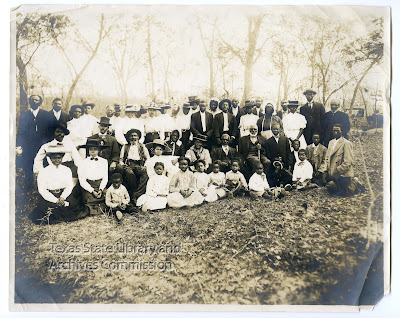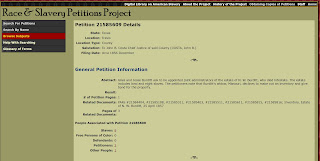 |
| Methodist Episcopal Church of Mount Salem Cemetery historical marker |
The Methodist Episcopal Church of Mount Salem Cemetery historical marker sits inside a private cemetery near old Sprinkle, Texas northeast of Austin. The marker text reads:
Trustees of the Methodist Episcopal Church of Mount Salem purchased three acres here in 1882 for a sanctuary and a cemetery. The building served as the central point for religious, educational and social activities for the Walnut Creek community until it was lost to a fire in the mid-1930s. Many graves are now unmarked, but descendants still care for the plot of Thomas Mack (1846-1919) and Ophelia Elizabeth (1857-1932) Madison, whose families farmed this land since prior to emancipation. The 1872 gravestone of Peter Elder is one of the oldest at this site that chronicles this early Travis County community.
But there's more to the story of Mount Salem.
About 1859 James Corry Maxwell (1840-1918), better known simply as J.C. Maxwell, left Virginia with some 25 enslaved persons settling on land near Sprinkle, Texas. At the outbreak of the Civil War Maxwell joined the Confederacy; after the war Maxwell's enslaved persons were freed. Some left the area, but others remained "renting" land from Maxwell; tenant farmers.
A church was established for what had become a freedmen's colony for persons formerly enslaved by Maxwell and quite possibly other landowners close by. In 19th century newspapers this church was referred to simply as "Mount Salem". There are also many references to "Mount Salem School"; it is not known for sure but quite possible that one building doubled as both the church and school.
The oldest headstones still standing in the cemetery that we were able to find is that of Peter Elder who died in 1872 (age 18, so pre-Civil War), and Sama Benford* who also died 1872 (age 6). But given Maxwell's plantation was established ca. 1859 there are likely many other unnamed burials. Evidence in the cemetery of collapsed graves without headstones are abundant.
* The "N" in Benford is backwards making it look like an incomplete "W". But there are three Benfords buried at nearby Walnut Creek Cemetery so name is almost certainly Benford.
The church is referenced in the news as early as 1877 (Austin American-Statesman (Austin, Texas) · 13 Mar 1877, Tue · Page 4). An article from 1881 talks about a "Mount Salem Lodge No.1 of United Sisters and Brothers of Charity" with a goal to "provide for the destitute and sick and bury the dead." (Austin American-Statesman (Austin, Texas) · 9 Aug 1881, Tue · Page 4). All to say the Mount Salem freedmen community's church and cemetery were clearly established prior to the purchase of the 3 acre property.
As noted on the marker, in 1882 the trustees of the Methodist Episcopal Church
of Mount Salem purchased three acres for a sanctuary and cemetery. While there is no reference to a school in the marker application, newspaper accounts clearly indicate there was one (again, the same building may have accommodated both the church and school; not known). An early reference to Mount Salem School comes in 1883 in reference to money allocated to public schools: "Mt. Salem, about 8 miles N.E. of city [Austin] ... $231.15" (Austin Weekly Statesman (Austin, Texas) · 11 Oct 1883, Thu · Page 4). If the dollar amount is a relative indicator of school size, Mt. Salem was a good size school, allocated more money than say neighboring Fiskville. Travis County Schools Superintendent Records at the Austin History Center indicate the school was officially recognized in 1884 (notes below). Another reference is from 1888 as part of an article listing Travis County public school teachers; the teacher that year was Ms. Sallie Taylor. (Austin American-Statesman (Austin, Texas) · 9 Sep 1888, Sun · Page 4). It is worth noting this is the same general time-frame Hayden Springs School was started, another early Travis County African American school suspected to be associated with a freedmen's colony (research ongoing) that closed and was largely forgotten (found on only one Travis County road map) after the Rosenwald schools began opening.
Much of what we know about J.C. Maxwell and the origins of the Mount Salem community come from a 1910 article describing a "barbecue" that J.C. Maxwell held for peoples he had formerly enslaved, and their descendants (New York Daily Tribune, Sunday, Feb 27, 1910, p.3). The article says that of the 25 formerly enslaved Maxwell brought from Virginia, 7 were still alive and the descendants of those 25 then numbered 148 men, women and children. Maxwell passed a few years later, in 1918. (Austin American-Statesman (Austin, Texas) · 8 Apr 1918, Mon · Page 8).
The cemetery is still in use, though many of the burials are unmarked. We know the name of at least one of the enslaved women brought to Texas from her obituary: "Aunt" Fannie Tucker, born 1825, brought to Texas in 1859 at the age of 34, died 1915 at 90 years of age. The obit says as an enslaved woman she was brought to Texas by wagon by Maxwell. She was a member of the Methodist Church; Mount Salem? The obit doesn't indicate where she was buried, but her death certificate says Oakwood. (Austin American-Statesman (Austin, Texas) · 24 Oct 1955, Mon · Page 16). Her death certificate indicates her maiden name was Fraction, and we have at least two known Fractions buried at Mt. Salem; relationships unknown.
The cemetery doesn't appear on USGS maps until 1988, and is also missing on early Travis County maps. Hopefully with continued research we can bring to life the story of this undertold freedmen's colony.
Maps, Aerials
 |
| 1898 Travis Co. roads map shows a "M. Fraction" about a mile plus east of the cemetery. Likely Moses Fraction. |
 |
| The cemetery didn't even show-up on USGS maps until about 1988. It is also absent from older Travis County maps. |
 |
| 1940 aerial super-imposed on Google Earth 2021. By 1940 the church building had burned, but the entrance to the property was still on the east facing Walnut Creek. Click to enlarge. |
Photos
 |
| Peter Elder. Oldest headstone still standing. Died 1872 at age 18; would have been born 1854. Was Peter Elder one of original 25 enslaved? |
 |
| Henry Dickerson (1815-1900). Henry Dickerson may have been enslaved by Giles and Jesse Burditt. See notes below. |
 | |
| Photo of formerly enslaved and descendants at 1910 "barbecue". Click to enlarge. |
 | |
| High resolution copy of 1910 barbecue group photo from TSL. Click to enlarge. |
 |
| Photo of meats being cooked, 1910 barbecue, from TSL. |
High resolution copies of some of these photos are available at the TSL as part of the WD Hornaday collection.
https://tsl.access.preservica.com/uncategorized/IO_d6438b94-110b-4974-891e-c80e93ea6d0b/
https://tsl.access.preservica.com/uncategorized/IO_efae8413-8b8e-4660-9d88-7b9cf92c407f/
References, Notes, Read More
Tip for searching Austin newspapers, search for just "Mount Salem" or "Mt. Salem".
Find a Grave https://www.findagrave.com/cemetery/2527883/methodist-episcopal-church-of-mount-salem
Read about Hayden Springs, another early African American school that was largely forgotten https://traviscountyhistorical.blogspot.com/2019/10/hayden-springs-school-near-manor-tx_2.html
The 1910 article about the "barbecue" Maxwell held for his formerly enslaved persons and their descendants ran in the New York Daily Tribune (Sunday, Feb 27, 1910, p.3). But the photos were obviously taken in Texas on his property suggesting there may be more photos available.
Information from Application for Official Historic Texas Cemetery (June 23, 1999) estimates 100+ burials and that an alternate name for the cemetery is Walnut Creek AME Cemetery.
See also Walt Roberts' article "Trekking After the Fact(s)", Walnut Creek Chronicle, Jourdan-Bachman Pioneer Farm, Vol. IX No.10, Austin, Texas, November-December 1998. One comment in that article worth mentioning: "A few remains seem to have been moved to other cemeteries" (italics mine). Suspect this conjecture was based on what are likely sunken, unmarked burials of which there are many.
As previously noted, Mt. Salem School appears to have started about the same time as Hayden Springs School funded by the "Public Free School Fund". The Austin History Center contains records on these early school districts that would be worth checking out including for example:
- County Judge's School Record. Orders to establish school districts #1-50, 1883-1884. Page 33. Available at Austin History Center, call # FP J.5 D.
- Austin History Center, Call # AR.J.005. Travis County Schools, Superintendent Records, Box 23
Handbook of Texas, about schools near Sprinkle: "Around 1900 Sprinkle was the focus of a common school district that had one school for sixty White students and one for forty-seven Black students. In the late 1930s these schools were consolidated with the Manor Independent School District." https://www.tshaonline.org/handbook/entries/sprinkle-tx
See also files at the Austin History Center concerning Mt. Salem school. 1884 register from the Travis County Schools Superintendent Records AR.J.005. These records show Mt. Salem was established "officially" August 30, 1884, School District No. 17, School No. 3, located at "Mt. Salem Church" (quoting from p.25). This would seem to confirm that the church building doubled as school.
Henry Dickerson
Henry Dickerson may have been enslaved by the Burditt family around Sprinkle. The Race & Slavery Petitions Project shows the family estate ca. 1856 included "land and eight slaves" (Giles and Jesse Burditt petition 21585609). Then in the 1880 census, Henry Dickerson and Giles Burditt are living in close proximity, both originally from Tennessee. Henry Dickerson also appears just north of the Giles Burditt on county road maps of 1898-1902. http://library.uncg.edu/slavery/petitions/details.aspx?pid=12736
 |
| Giles and Jesse Burditt petition 21585609 ca. 1856 |
 |
| 1880 census. Giles Burditt and Henry Dickerson live in close proximity with Tennessee place of birth. |
Moses Fraction & Mrs. Fannie (Fraction) Tucker
In the photo of Moses Fraction and Mrs. Fannie (Fraction) Tucker together -- probably from the 1910 gathering -- the question arises, what's their relationship. From the 1900 census a probable answer is they are siblings being near in age.
 |
| Moses Fraction in the 1900 census |
 |
| Fanny Tucker in the 1900 census |
And when you look at the
neighbors, just a few houses away is Walter Custard (he's on the county road
maps near the Maxwell property); and then some Maxwells. So this is surely there by Sprinkle.
Moses Fraction discovered in 1880 United States Federal Census - https://www.ancestry.com/sharing/26266237?h=760464 via @Ancestry
It all looks like well this has got to be the family. But then you look at the ages in 1880 and Fannie is 6 years old (born 1874?).
But Mrs. Fannie Fraction Tucker’s death certificate says she was born in 1826? Her father is Moses, but her mother is Virginia? The mother’s name one might understand – people go by different names – but Fannie’s date of birth 1826 vs. 1874 – that’s way off. And headstone dates on Sally or Rohdy’s dates didn’t line up either.
Could the death certificate
be wrong? Could the census data be wrong? Do we have multiples of Moses /
Fannie / Sally / Rhody ? So .. not sure what to make of that.
 |
| Moses Fraction in the 1880 census |
 |
| Fannie Fraction Tucker's death certificate: b.1826 d.1915 |
Kingdom Come! Kingdom Go!
Below are pages from Appendix C & K from Kingdom Come! Kingdom Go!, by Mary Jourdan Atkinson & Eugene V. Giles, 1980. Some language from the 1909 news article presents racist stereotypes of that period, but provides history on many of the formerly enslaved persons associated with Mt. Salem. Click to enlarge pages.
 |









Another excellent blog, thank you Rich!!
ReplyDelete